The six-time Mr. Olympia champ Dorian Yates (1992 to 1997) is one of the most respected athletes in the sport and is considered a pioneer as he revolutionized how people thought about strength training for hypertrophy.
“The Shadow” is credited with beginning the mass monster era in professional bodybuilding.
Yates preferred high-intensity training (HIT) over the conventional bodybuilding routines that involved training six days a week and performing an endless number of sets and reps for every exercise.
I decided to try this low-volume, maximal-effort routine for myself, and this Yates-inspired two-week HIT challenge was born.
In this article, I take you over my experience with this 14-day experiment and how it impacted my strength gains and muscle soreness. I’ll also share tips on how you can implement this challenge in your own routine.
What Is Dorian Yates’ HIT?
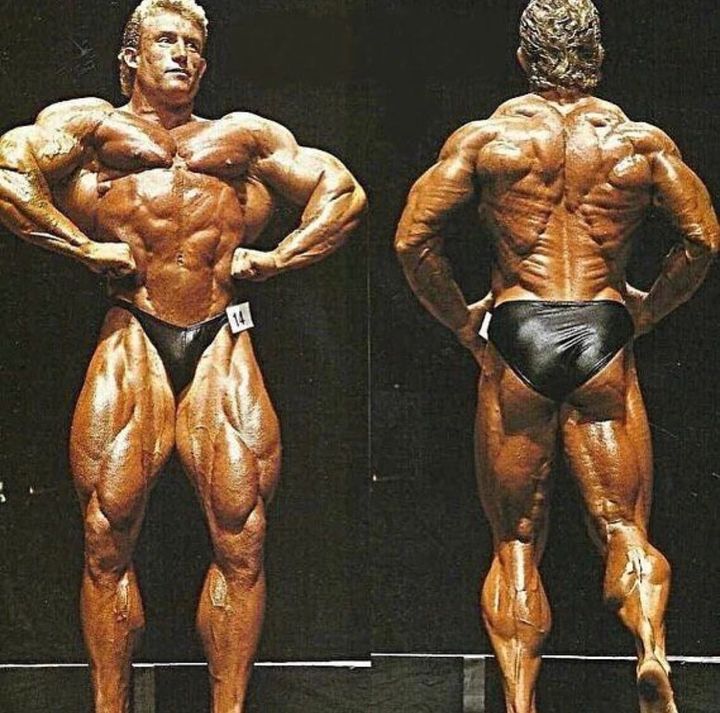
HIT isn’t just another gym fad. It is a philosophy, a brutal, efficient way to ignite new muscle growth. It was conceptualized by Arthur Jones in the 1970s and refined by Yates in the 90s.
Level Up Your Fitness: Join our 💪 strong community in Fitness Volt Newsletter. Get daily inspiration, expert-backed workouts, nutrition tips, the latest in strength sports, and the support you need to reach your goals. Subscribe for free!
HIT focuses on one, all-out set per exercise. Each rep is supposed to push you closer to your absolute limit, and you must stop only when you can’t push anymore. Since you are only doing a limited number of sets and reps, you must go as heavy as possible while maintaining total control over the weight.
One of the best things about this training split is that it usually lasts between 30 and 45 minutes, making it suitable even for the busiest people.
Many people confuse HIT with high-intensity interval training (HIIT). However, there is a stark difference. HIIT Training bombards the muscle with multiple sets and exercises. In the HIT world, that would be considered junk volume.
The 2-Week HIT Experiment: How I Did It
Yates followed a four-day training split, training each muscle group once weekly. This gave his body enough time to recover while ensuring optimal muscle stimulation.
- Day 1: Shoulders, Triceps, and Abs
- Day 2: Back and Rear Delts
- Day 3: Rest
- Day 4: Chest and Biceps
- Day 5: Rest
- Day 6: Legs (Quads, Hamstrings, and Calves)
- Day 7: Rest
Before we jump into the specifics, let’s talk a little about Yates’ HIT routine. He usually did one set to failure for each exercise after completing one to two warm-up sets. That said, Yates performed four to five exercises for each muscle group to work the fibers from every angle possible and promote overall development.
Yates took a day off after training bigger muscle groups like the back, chest, and legs to ensure his muscles had enough time to recover between the sessions.
While Yates went hard and heavy in each exercise, he prioritized his form to make the most out of each lift while limiting the risk of injury.
Day 1: Shoulders, Triceps, and Abs
Since Yates went full-send in each session, he trained each muscle group once a week, and I followed suit.
Make no mistake, training three different muscles in a single workout hit me like a freight train. Although I was only doing around 10 to 14 sets in each workout, the overall intensity pushed me to my limits.
| Exercise | Warm-up Sets | Working Sets | Reps | Rest |
| Smith Machine Shoulder Press | 2 | 1 | 6-8 | 2-3 min |
| Lateral Raises | 1 | 1 | 8-10 | 2 min |
| Rear Delt Flyes | 1 | 1 | 8-10 | 2 min |
| Tricep Pushdowns | 1 | 1 | 6-8 | 2 min |
| Skull Crushers | 1 | 1 | 6-8 | 2 min |
| Hanging Leg Raises | 0 | 1 | To failure | 1 min |
Day 2: Back and Rear Delts
A proper warm-up is crucial in HIT to prevent injury and prime the muscles for maximum intensity. I started each session with a five to 10-minute dynamic stretching routine or light cardio to increase my core body temperature.
The primary objective of the warm-up sets was to feel the weight and get comfortable with the movement mechanics. If an exercise had two warm-up sets, I lifted 50% of the working weight on the first set and 75% on the second. On the other hand, if it only had one working set, I aimed for something in the middle of the 50 to 75% range.
The working set, however, was 100% effort to failure.
Coach Tip: Yates always trained with a spotter when prepping for the Olympia. An experienced spotter can keep you accountable and motivated, helping you get the most out of each rep. I followed in Yates’ footsteps and recruited a training partner to help me with this two-week challenge.
| Exercise | Warm-up Sets | Working Sets | Reps | Rest |
| Nautilus Pullover | 2 | 1 | 6-8 | 2-3 min |
| Barbell Rows | 2 | 1 | 6-8 | 2-3 min |
| Lat Pulldowns | 1 | 1 | 8-10 | 2 min |
| Seated Cable Rows | 1 | 1 | 8-10 | 2 min |
| Face Pulls | 1 | 1 | 10-12 | 2 min |
Day 4: Chest and Biceps
Drawing inspiration from Yates, I performed each rep with a strict form, focusing on controlled negatives. I spent 3-4 seconds on the lowering phase to maximize the time under tension and subsequent adaptations. (1)
This also helped deepen the mind-muscle connection, leading to more intense muscle pumps. I doubled down on this by contracting the target muscles as hard as possible with each rep.
| Exercise | Warm-up Sets | Working Sets | Reps | Rest |
| Incline Bench Press | 2 | 1 | 6-8 | 2-3 min |
| Flat Dumbbell Press | 1 | 1 | 8-10 | 2 min |
| Cable Flyes | 1 | 1 | 10-12 | 2 min |
| Barbell Curls | 1 | 1 | 6-8 | 2 min |
| Incline Dumbbell Curls | 1 | 1 | 8-10 | 2 min |
Day 6: Legs
The leg workouts were definitely the hardest part of this two-week challenge. Every set was an all-out effort, no holding back. Since I had only two weeks to make it count, I had to give my best in each rep.
I employed forced reps with the help of my training partner to push beyond mechanical failure on the last set of the key exercises. This technique can increase muscle fiber damage, leading to greater subsequent growth.
| Exercise | Warm-up Sets | Working Sets | Reps | Rest |
| Leg Extensions | 1 | 1 | 10-12 | 2 min |
| Leg Press | 2 | 1 | 8-10 | 2-3 min |
| Hack Squats | 1 | 1 | 6-8 | 2-3 min |
| Lying Leg Curls | 1 | 1 | 8-10 | 2 min |
| Standing Calf Raises | 1 | 1 | 10-12 | 2 min |
Weekly Summary of the 2-Week Dorian Yates HIT Workout Challenge
Here is an overview of how these 14 days panned out for me:
Level Up Your Fitness: Join our 💪 strong community in Fitness Volt Newsletter. Get daily inspiration, expert-backed workouts, nutrition tips, the latest in strength sports, and the support you need to reach your goals. Subscribe for free!
Week 1
Since this workout routine was all about intensity, I visualized successful lifts and muscle growth before starting each session. I realize that going into these workouts without mental preparation could be a big mistake, as I would need to be in tune with my muscles from the very first rep to make the most out of this short challenge.
Progressive overload is the backbone of this challenge. As a veteran trainer, I have been tracking my workouts religiously for the last five years. I aimed to add at least 2.5 pounds to each exercise in every subsequent workout compared to what I was lifting earlier.
I completed the first workout in under 45 minutes. However, the high-intensity routine led to significant delayed onset muscle soreness (DOMS) the very next day.
I prioritized eight to nine hours of sleep each night to allow my muscles enough time to recover and rebuild. Plus, I increased my calorie and protein intake to ensure my muscles had all the raw materials they needed to grow bigger and stronger.
Instead of turning into a couch potato, I went outdoors for a 20 to 30-minute walk to promote blood flow to all the muscles and boost recuperation. (2)
In my opinion, the biggest challenge this week was to gauge the right weight for the final failure set.

Week 2
As my body got used to this high-intensity routine, it was now time to switch gears.
This workout routine was as mentally challenging as it was physically demanding. Coming from a typical bro split routine, I had to mentally adjust to these shorter, more intense workouts.
Allowing myself some time to adjust paid dividends as it resulted in a better mind-muscle connection.
I also gained confidence in the second phase, allowing me to push myself closer to mechanical failure in every set. Since I was only doing one heavy set per exercise, I noticed much better strength gains in key lifts like the bench press and squat.
The soreness also subsided, and DOMS no longer restricted my performance during the final push.
Physical Results: Strength Gains and DOMS
Let’s now talk about the results so you can determine if this is the right routine for you.
Strength gains are among the most tangible outcomes of any training program. Here’s how my lifts changed over this two-week period:
| Exercise | Starting Weight | Ending Weight | Increase |
| Squat | 275 pounds | 290 pounds | 15 pounds |
| Bench Press | 225 pounds | 230 pounds | 5 pounds |
| Deadlift | 315 pounds | 335 pounds | 20 pounds |
| Shoulder Press | 135 pounds | 140 pounds | 5 pounds |
I must add that I was going through a detraining period before starting this split, and my muscle memory kicked in as soon as I switched to this high-intensity routine. Your gains can vary from mine depending on your starting fitness levels and training objectives.
I experienced DOMS constantly during this experiment. However, they were the most severe after the first week’s workout and typically lasted anywhere between 48 to 72 hours. The soreness was less prominent in the second week but still noticeable, especially after the leg day.
My muscles felt firmer and more pumped during the second week, and I noticed an improvement in my arm and shoulder vascularity by the end of the two weeks. I ended up gaining 2 pounds over this period because of the increased calorie intake. However, there were no significant visible changes in body fat levels.
Mental Challenges: Pushing Past the Limit
Although two weeks is a relatively short period when it comes to making noticeable muscle gains, the mental shift was profound.
As someone who spends most of his days in the gym, I thought I knew intensity. HIT proved me wrong. The idea of pushing myself to the limit in every set was daunting. I had to embrace mechanical failure as a sign of growth and visualize each set as a battle I had to win.
Honestly, constantly maxing out in every exercise drained me mentally, and I had to prioritize mental recovery just as much as physical recovery. I used meditation and visualization between workouts to recharge.
As a result, my discipline and confidence skyrocketed and spilled into my daily life, improving my overall productivity and output.
Since I was happy with the results I got from this 14-day split, I decided to follow it for 10 more weeks. However, I will be using deload weeks at least twice during this period to reduce the risk of overtraining and overuse injuries.
Yates’ HIT split is perfect for people with a busy schedule who cannot hit the gym every day. The 45-minute workouts are potent enough to result in substantial muscle and strength gains over a long enough period.
I must add that these high-intensity workouts have their fair share of downsides. You are at a high risk of exhaustion and overtraining while following this routine. Hence, I would only recommend this to intermediate and advanced athletes who have a decent amount of lifting experience under their belts.
Conclusion
Just two weeks of following Yates’ HIT routine increased my deadlift strength by 20 pounds. I can only imagine what it will do if I stick with it for 10 more weeks.
As with any other training routine, you must be consistent and disciplined to make the most out of this two-week Yates-inspired HIT challenge. Beginners should start small and gradually increase the training volume and intensity as they gain more experience.
If you have any questions about Dorian Yates’ HIT routine or need help implementing it into your routine, post them in the comments below, and I’ll be happy to help!
References:
- Burd NA, Andrews RJ, West DW, Little JP, Cochran AJ, Hector AJ, Cashaback JG, Gibala MJ, Potvin JR, Baker SK, Phillips SM. Muscle time under tension during resistance exercise stimulates differential muscle protein sub-fractional synthetic responses in men. J Physiol. 2012 Jan 15;590(2):351-62. doi: 10.1113/jphysiol.2011.221200. Epub 2011 Nov 21. PMID: 22106173; PMCID: PMC3285070.
- Ortiz RO Jr, Sinclair Elder AJ, Elder CL, Dawes JJ. A Systematic Review on the Effectiveness of Active Recovery Interventions on Athletic Performance of Professional-, Collegiate-, and Competitive-Level Adult Athletes. J Strength Cond Res. 2019 Aug;33(8):2275-2287. doi: 10.1519/JSC.0000000000002589. PMID: 29742750.

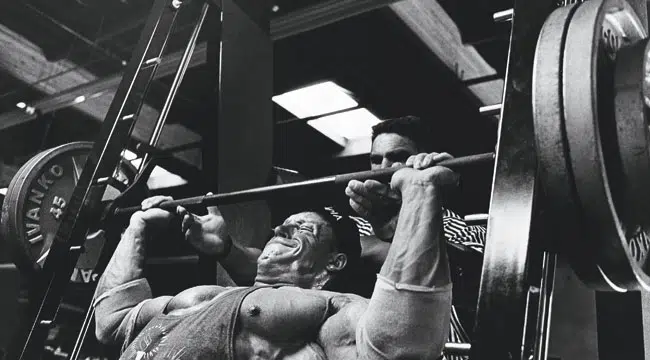
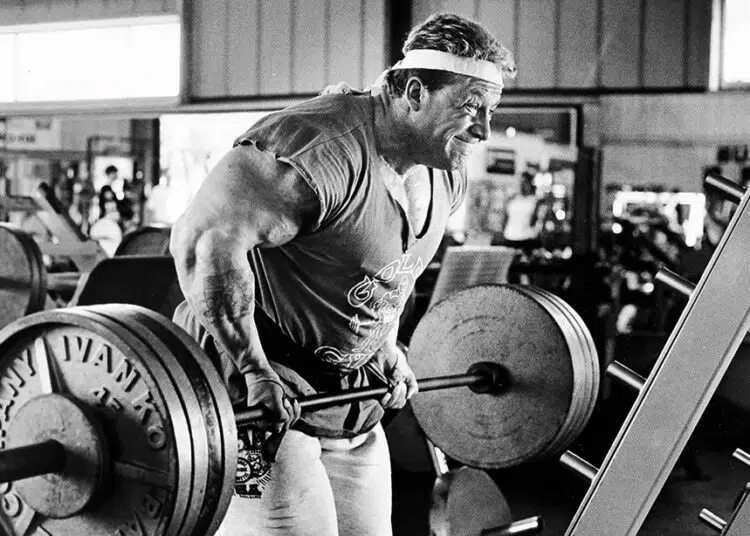
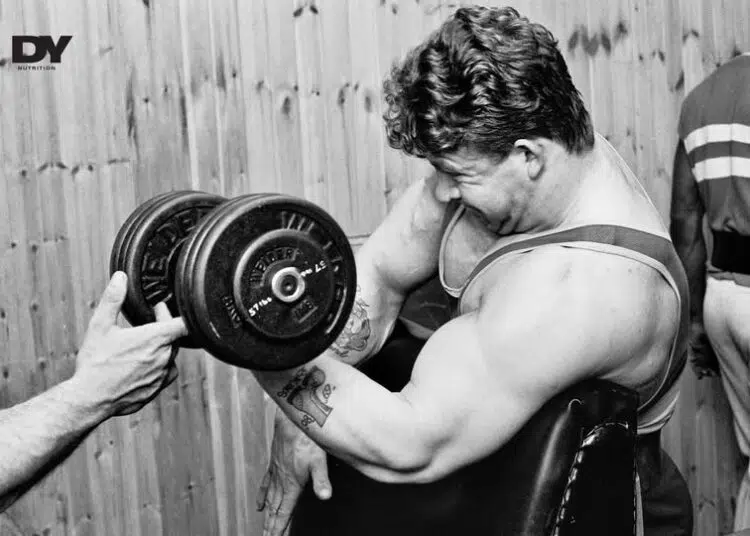
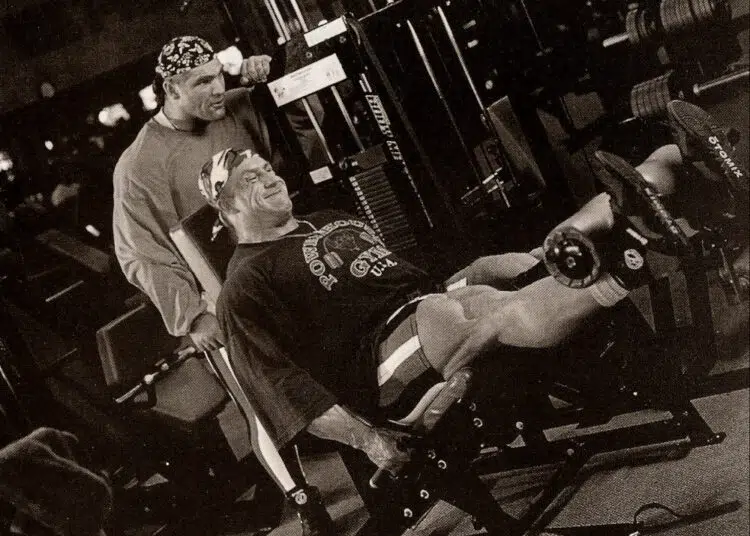
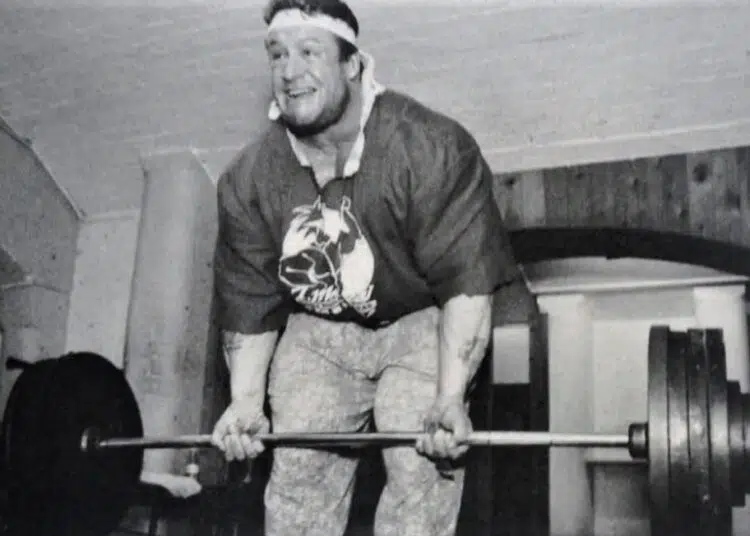





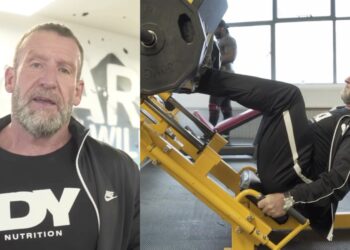


Did you write anything about your Full 10 weeks training Dorian Yates style
Hi Pierre,
This was a 2-week experiment. We do have a 10-week challenge lined up so please stay tuned for that.